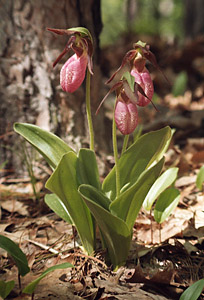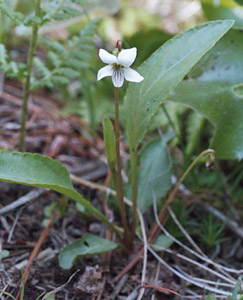


Pink Lady's Slipper or Moccasin Flower, Orchid family (Orchideaceae), Native
 |
 |
 |

Like many other orchids, pink lady's slipper needs its growing conditions to be just right. It is very
difficult to grow from seed or to transplant. The soil must be quite acidic, and it must contain
a particular type of fungus (Rhizoctonia) which helps the seeds germinate and grow. In turn, the
seedlings supply the fungus with food from photosynthesis. This complex symbiotic relationship
helps to make the plant uncommon. Lady's slipper plants can take years to mature, and their
average life span is about 20 years.

Wild Geranium, Geranium family (Geraniaceae), Native
 In moist, partly shaded, wooded areas, wild geranium (Geranium maculatum) plants produce their light purple flowers in late May and early June. The one-inch blossoms are relatively large for a woodland wildflower, and the plant has large, deeply cut, five-part leaves. Its pollen is an unusual bright blue, rather than yellow or orange as in most plants. Another common name for the plant is cranesbill, which refers to the graceful shape of its long, slender, curved seedpods. The pods develop as the flower petals wilt and drop off, as the photo shows. When the seeds are ripe, the pods pop open and send the seeds flying into the surroundings. Once on the ground, a seed can push itself along as its "tail" alternately dries out and curls and then absorbs moisture and straightens out. Wild geranium has a long history of medicinal use, going back to early Native Americans. The tannin in its leaves made it useful as an astringent and styptic. It was also used in mouthwashes and gargles. This wild geranium is a native of North America, although some similar species are not. It is not related to to the familiar "geraniums" that are so popular in hanging pots and flower boxes. These plants are pelargoniums, originally imported for gardens from South Africa. |
Lance-leaved Violet, Violet family (Violaceae), Native

|

Lance-leaved violet (Viola lanceolata) is a white violet with long, narrow leaves, as the name
suggests. It usually grows in swamps or wet places.
Besides reproducing by seed, lance-leaved violets can spread by sending out above-ground runners from which
new plants grow. All the plants in a patch of these violets may in fact be one individual. This type of
reproduction gives this violet a way of spreading quickly in a favorable location.
| show TOC frame | Table of Contents | 
|
| Home / Contact | ||
Copyright © Anne A. Reid, 1999-2002. Photographs copyright © Garry K. Kessler, 1999-2002. | ||